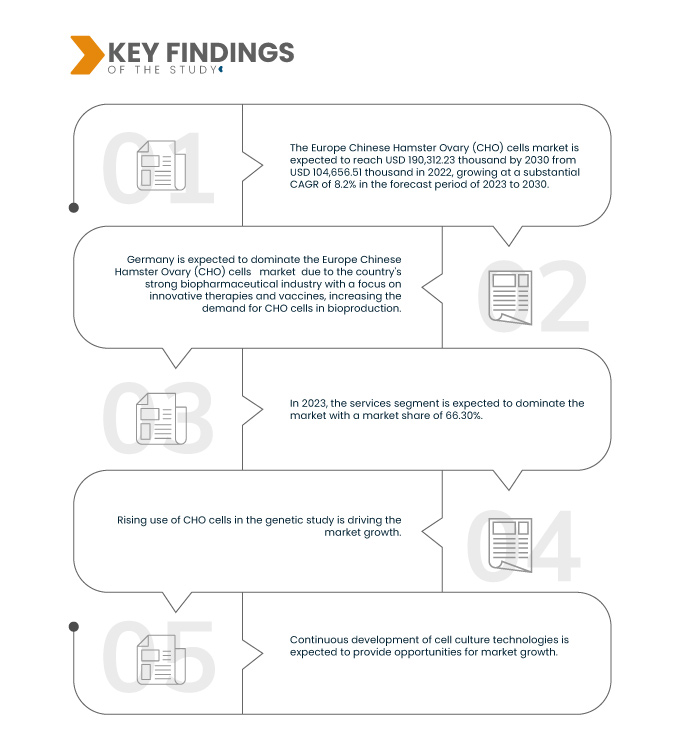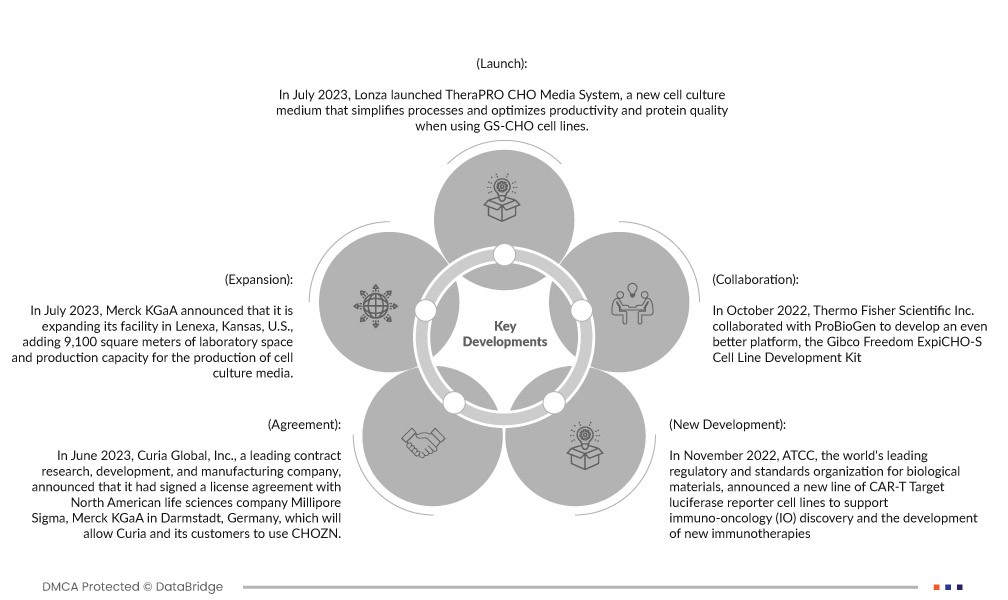The growing demand for biopharmaceuticals continues to be a powerful driver for the Europe Chinese Hamster Ovary (CHO) cells market. This surge in demand is fueled by several factors such as the aging population in Europe and the increasing prevalence of chronic diseases that have led to an elevated need for advanced therapies and medications. Biopharmaceuticals, which include monoclonal antibodies, recombinant proteins, and vaccines, offer targeted and highly effective treatment options for various medical conditions. In addition, the ongoing R&D of innovative biopharmaceuticals for previously untreatable or rare diseases contributes to the increasing demand for CHO cells. These cells serve as a fundamental component in the biomanufacturing process for producing these novel therapies.
Access Full Report @ https://www.databridgemarketresearch.com/reports/europe-chinese-hamster-ovary-cells-cho-market
Data Bridge Market Research analyzes that the Europe Chinese Hamster Ovary (CHO) Cells Market is expected to reach USD 190,312.23 thousand by 2030 from USD 104,656.51 thousand in 2022, growing at a substantial CAGR of 8.2% in the forecast period of 2023 to 2030.
Rising Use of CHO Cells in the Genetic Study
CHO cells have gained prominence in genetic research due to their adaptability and versatility in genetic manipulation and expression systems. Researchers and biotechnologists across Europe are increasingly relying on CHO cells to investigate various aspects of genetics, including gene expression, genome editing, and functional genomics.
CHO cells provide a stable and well-characterized platform for genetic studies, making them an essential resource for understanding gene function, protein expression, and developing new therapeutic agents. This rising interest in genetic research using CHO cells not only fuels the demand for CHO cells but also drives innovations in biotechnology and genetic engineering techniques. Consequently, the market is experiencing growth as it caters to the expanding needs of the scientific community engaged in genetic research and biotechnology, further solidifying its position in the life sciences sector.
Report Scope and Market Segmentation
|
Report Metric
|
Details
|
|
Forecast Period
|
2023 to 2030
|
|
Base Year
|
2022
|
|
Historic Years
|
2021 (Customizable to 2015-2020)
|
|
Quantitative Units
|
Revenue in USD Thousand, ASP in USD, and Volume in Thousand
|
|
Segments Covered
|
Type (Services and Product), System (Metabolic Selection System, Antibiotic Selection System, and Others), Application (Biologics and Medical Research), End User (Biopharmaceutical Companies, Biotechnology Companies, Clinical Development and Manufacturing Organizations, Clinical Research Organizations, Academic Institutes and Research Organizations, and Others), Distribution Channel (Direct Tenders, Retail Sales, and Others)
|
|
Countries Covered
|
Germany, U.K., France, Russia, Italy, Spain, Turkey, Poland, Belgium, Netherlands, Switzerland, Denmark, Sweden, Norway, Finland, and Rest of Europe
|
|
Market Players Covered
|
Abeomics (U.S.), AcceGen (U.S.), Applied Biological Materials Inc. (abm) (Canada), ATCC (U.S.), BPS Bioscience, Inc. (U.S.), CLS Cell Lines Service GmbH (Germany), Curia Global, Inc. (U.S.), Cytiva (U.S.), GenTarget Inc. (U.S.), GTP Bioways (France), Horizon Discovery Ltd. (U.K.), Lonza (Switzerland), Merck KGaA (Germany), Promega Corporation (U.S.), RayBiotech Life, Inc. (U.S.), Sartorius AG (Germany), Thermo Fisher Scientific Inc. (U.S.) and among others
|
|
Data Points Covered in the Report
|
In addition to the insights on market scenarios such as market value, growth rate, segmentation, geographical coverage, and major players, the market reports curated by the Data Bridge Market Research also include in-depth expert analysis, patient epidemiology, pipeline analysis, pricing analysis, and regulatory framework.
|
Segment Analysis
The Europe Chinese Hamster Ovary (CHO) cells market is segmented into five notable segments based on type, system, application, end user, and distribution channel.
- On the basis of type, the market is segmented into services and product.
In 2023, the services segment is expected to dominate the Europe Chinese Hamster Ovary (CHO) cells market
In 2023, the services segment is expected to dominate the market with a market share of 66.30% due to the increasing demand for contract manufacturing and cell line development services, which offer flexibility and expertise to biopharmaceutical companies without substantial infrastructure investment.
- On the basis of system, the market is segmented into metabolic selection system, antibiotic selection system, and others.
In 2023, the metabolic selection system segment is expected to dominate the Europe Chinese Hamster Ovary (CHO) cells market
In 2023, the metabolic selection system segment is expected to dominate the market with a market share of 73.79% due to its efficiency in generating high-producing CHO cell lines for biopharmaceutical production.
- On the basis of application, the market is segmented into biologics and medical research. In 2023, the biologics segment is expected to dominate the market with a market share of 73.78%.
- On the basis of end user, the market is segmented into biopharmaceutical companies, biotechnology companies, clinical development and manufacturing organizations, clinical research organizations, academic institutes and research organizations, and others. In 2023, the biopharmaceutical companies segment is expected to dominate the market with a market share of 43.24%.
- On the basis of distribution channel, the market is segmented into direct tenders, retail sales, and others. In 2023, direct tenders segment is expected to dominate the market with a market share of 68.92%.
Major Players
Data Bridge Market Research analyzes Lonza (Switzerland), Sartorius AG (Germany), Merck KgaA (Germany), Cytiva (U.S.), Thermo Fisher Scientific Inc. (U.S.) as the major market players in the Europe Chinese Hamster Ovary (CHO) cells market.
Market Developments
- In July 2023, Lonza launched TheraPRO CHO Media System, a new cell culture medium that simplifies processes and optimizes productivity and protein quality when using GS-CHO cell lines. The startup supports pharmaceutical and biotech companies producing therapeutic proteins to further improve product quality. The TheraPRO CHO Media System provides efficient performance, achieving high concentrations of viable cells and protein titers above 5 g/L over a 15-day culture period. This represents more than double the protein titer that can be produced with commercially available solutions. This launch helped the company to expand its product portfolio in the market.
- In July 2023, Merck KGaA announced that it is expanding its facility in Lenexa, Kansas, U.S., adding 9,100 square meters of laboratory space and production capacity for the production of cell culture media. This expansion made Lenexa the company's largest dry powder cell culture facility and a center of excellence in North America. The investment in the region reflected the company's strategy to expand and diversify its supply chain to meet current and future demand for cell culture platforms.
- In June 2023, Curia Global, Inc., a leading contract research, development, and manufacturing company, announced that it had signed a license agreement with North American life sciences company Millipore Sigma, Merck KGaA in Darmstadt, Germany, which will allow Curia and its customers to use CHOZN. GS-/- cell line for the production of proteins and antibodies for therapeutic purposes. Following the agreement, the CHOZN GS-/- cell line will be integrated into Curia's cell line development workflow and immediately available to Curia's customers.
- In November 2022, ATCC, the world's leading regulatory and standards organization for biological materials, announced a new line of CAR-T Target luciferase reporter cell lines to support immuno-oncology (IO) discovery and the development of new immunotherapies. These models have a high endogenous expression of relevant chimeric antigen receptor (CAR) T target antigens such as HER2, CD19, and CD20. These new IO tools consist of both hematologic cancers and solid tumor cell lines expressing a luciferase reporter. This helped the company to expand its product portfolio.
- In October 2022, Thermo Fisher Scientific Inc. collaborated with ProBioGen to develop an even better platform, the Gibco Freedom ExpiCHO-S Cell Line Development Kit. This kit allows users to generate cell lines suitable for clinical development without their own original cells, vectors, or previous experience in the field. ProBioGen significantly contributed to the performance of the Freedom ExpiCHO-S kit by leveraging its strong expertise in cell line and process development. The new series utilizes Thermo Fisher's ExpiCHO-S cell line, expanding the company's product portfolio for the CHO cell line development series.
Regional Analysis
The countries covered in the Europe Chinese Hamster Ovary (CHO) cells market are Germany, U.K., France, Russia, Italy, Spain, Turkey, Poland, Belgium, Netherlands, Switzerland, Denmark, Sweden, Norway, Finland, and Rest of Europe.
As per Data Bridge Market Research analysis:
Germany is expected to dominate and to be fastest growing country in the Europe Chinese Hamster Ovary (CHO) cells market
Germany is expected to dominate and to be fastest growing country in the market due to its leadership in the market driven by its advanced biopharmaceutical industry, strong research institutions, and skilled workforce, making it a prominent hub for CHO cell-based biopharmaceutical production.
For more detailed information about the Europe Chinese Hamster Ovary (CHO) cells market report, click here- https://www.databridgemarketresearch.com/reports/europe-chinese-hamster-ovary-cells-cho-market












